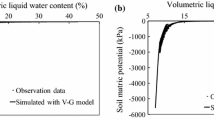A physical heat transfer model of the vertical vapor-liquid seasonal cooling device (SCD) inserted into soil and filled with Freon is considered. In the model, it is assumed that heat exchange with soil occurs at a constant coolant temperature, which corresponds to Freon phase transition temperature and depends exclusively on Freon properties and gas pressure inside the pipe. At a condenser temperature below the phase transition temperature, the SCD functions as a liquid thermosiphon due to enthalpy variation. The physical model of the vapor-liquid SCD is realized as a module in the TEMPA software package representing an internal heat source. The package is designed to solve non-steady-state thermophysical problems by the enthalpy method while considering phase transitions of the bound moisture.
Similar content being viewed by others
References
E. L. Long, "The long thermopile," First Intern. Conf. on Permafrost, Purdue University. US National Academy of Sciences (1963), pp. 487-490.
F. D. Haynes and J.P. Zarling, "Thermosiphons and foundation design in cold regions," Cold Regions Science and Technology, 15, 251-259 (1988).
J. D. Gill, "Foundation stabilization of an ongrade structure," 3rd Cold Reg. Eng. Spec. Conf., Montreal, Canadian Society for Civil Engineering (1984), pp.1091-1099.
E. Yarmak Jr. and E.L. Long, "Recent developments in thermosiphon technology," Proc. 11th Int. Conf. Cold Reg. Eng., Anchorage, Alaska, May (2002), pp. 656-662.
I. Holubec, Flat Loop Thermosiphon Foundations in Warm Permafrost, Report submitted to Government of the Northwest Territories, Asset Management Division (2008).
Thermosiphon foundations for buildings in permafrost regions, National Standard of Canada, CAN/CSA-S500-14 (2014).
A. M. Wagner, Review of Thermosiphon Applications, The US Army Eng. Res. Devel. Center (ERDC), TR-14-1 (2014).
S. I. Gapeev, Strengthening of Frozen Bases by Cooling [in Russian], Stroyizdat, Leningrad (1969).
V. I. Makarov, Thermosiphons in Northern Construction [in Russian], Nauka, Novosibirsk (1985).
G. P. Pustovoyt, "Two methods of selecting optimal design solutions for foundation stability on permafrost," Soil Mech. Fund. Eng., 36, No. 3, 101–105, (1999).
E. V. Ibragimov, Ya. A. Kronik, and G. P. Pustovoyt, "Experience using heat pumps as soil heat stabilization systems in a cryolithological zone," Soil Mech. Fund. Eng., 52, No. 3, 273–276 (2015).
V. G. Condratyev, "New methods and technologies of managing soil condition of the railbed body and base in cryolithozone," Geotekhnika, No. 2, 28-40 (2011).
S. A. Kudryavtsov, I.I. Sakharov, and V.N. Paramonov, Freezing and Thawing of Soils (Practical Examples and Finite-Element Calculations) [in Russian], Georekonstruktsiya, St. Petersburg (2014).
Ya. B. Gorelik and A.A. Seleznev, "On the efficiency of finning two-phase natural-convection cooling devices for construction on permafrost soils," Kriosfera Zemli, 20, 2, 78-89 (2016).
SP 25.13330.2012, Bases and Foundations on Permafrost Soils [in Russian], Moscow (2012).
V. V. Onosovskii, V.S. Sokolov, N.A. Buchko, and Yu.N. Obraztsov, "Study of thermopiles filled with low-boiling liquid," Kholod. Tekhn., No. 12, 21-26 (1971).
O. B. Tsvetkov and Yu.A. Laptev, Tables of Refrigerant Properties [in Russian], St. Petersburg (2013).
L. L. Vasilyev and S. L. Vaaz, Freezing and Heating of Soil Using Cooling Devices, ed. by L. I. Kolykhan [in Russian], Nauka i Tekhnika, Minsk (1986).
A. A. Plotnikov, "Calculation of temperature regime of permafrost bases," Energ. Stroit., No. 8, 70-73 (1978).
A. A. Plotnikov, "Numerical solution of the thermal conductivity problems in frozen soils by the enthalpy method," in: Thermodynamic Aspects of the Mechanics of Frozen Soils, Nauka, Moscow (1988), pp. 86-94.
P. P. Permyakov, S. P. Varlamov, and M. N. Zheleznyak, "Impact of a vertical seasonal cooling device on the thermal and moisture regime of the soil," Kriosfera Zemli, 21, No.1, 66-72 (2017).
G. O. Lukin, "Geothermal regime of soils under the city of Yakutsk buildings," in: Processes of heat and mass transfer in frozen rocks, Nauka, Moscow (1965), pp. 111-122.
V. M. Yefimov, F. Ye. Popenko, I. I. Rozhin, A. V. Stepanov, and K. N. Bolshev, "Formation of the soil temperature of the bases when using seasonal cooling devices under the cryolithozone conditions of central Yakutia," Arktika i Antarktika, No. 4, 98-105 (2017).
Author information
Authors and Affiliations
Corresponding author
Additional information
Translated from Osnovaniya, Fundamenty i Mekhanika Gruntov, No. 6, pp. 25-29, November-December, 2019.
Rights and permissions
About this article
Cite this article
Plotnikov, A.A. Physical Heat Transfer Model of Two-Phase Seasonal Cooling Device. Soil Mech Found Eng 56, 445–451 (2020). https://doi.org/10.1007/s11204-020-09628-5
Published:
Issue Date:
DOI: https://doi.org/10.1007/s11204-020-09628-5




